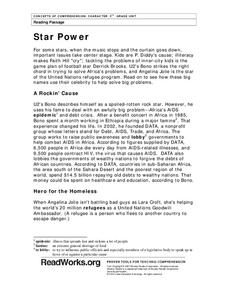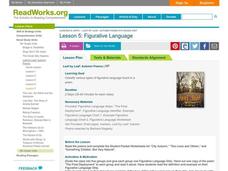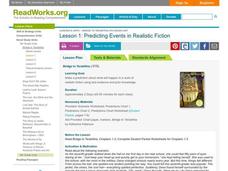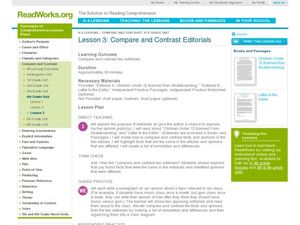Read Works
The United States Constitution
The US Constitution is the beginning of Americans' rights. Use a five-paragraph passage to give a brief history of the US Constitution. A great last minute addition to a lesson on Constitution Day.
Read Works
A Constitution for Kids
What better day to celebrate the US Constitution than on Constitution Day! After reading a short passage about the different understandings of habeas corpus and ex post facto, sixth graders respond to 10 multiple choice and short...
Read Works
Canine Courage
Did you know dogs had an important job on September 11th, the day airplanes took down the World Trade Center? Learn more about the furry heroes with a three-page informational read designed to aid pupils in answering 10...
Read Works
Plymouth Colony
Read about the tumultuous beginning to the United States with an informational text passage about Colonial America. As young researchers peruse an article about the arrival of the Mayflower, the settlers' relationship to the neighboring...
Read Works
Star Power
Angelina Jolie, Bono, and P. Diddy all have something in common: they use their fame to contribute to society in such a way that makes the world a better place. After reading a three-page passage on the types of causes to...
Read Works
A Bird Came Down the Walk
"A Bird Came Down the Walk" by Emily Dickinson is the focus text of a narrative poetry-based reading comprehension learning exercise. After reading her poem, young readers respond to seven multiple choice and...
Read Works
Fireflies
A short story about a nighttime adventure at summer camp provides readers with a chance to practice their comprehension skills.
Read Works
Figurative Language
Do your learners need to practice identifying figurative language? This lesson outlines a method for working on that tricky skill. After teacher modeling and think-aloud, fourth and fifth graders identify examples of figurative language...
Read Works
Signal Words in Expository Text
Signal words are one way that authors make the relationships between their ideas clear. Allow your learners the chance to investigate cause and effect in texts by identifying signal words. They locate and analyze cause-and-effect...
Read Works
The Language of Setting
Examine the connection between descriptive language and emotional impact. For the first few chapters of The Lion, the Witch and the Wardrobe by C.S. Lewis, learners record the descriptive writing the author used to vivify the...
Read Works
The Language of Setting
Descriptive language can be used to create a vivid and imaginative setting. Create the chart suggested in this plan to track the descriptive language found in The Wizard of Oz by L. Frank Baum. The class discusses the land beyond...
Read Works
Lesson 4:Theme Matters
Determining a theme is one of the most difficult and most important standards in the Common Core. Use this plan to help your learners identify the message that an author is sending to the reader. The lesson is based around the book Dogs...
Read Works
What's the Main Idea?
By sharing a summary about their favorite book or movie, your young readers can then discuss the main ideas of their beloved stories. The concept transitions to finding the main idea in poetry. Class members use textual clues in various...
Read Works
Writing a Research Report
Transfer information from an outline into a well-developed research report. Using an already-written outline, model how to write an introductory paragraph and a body paragraph. Work through the conclusion as a class before allowing time...
Read Works
Identifying Plot Conflicts
Examine the conflicts in The Great Gilly Hopkins by Katherine Paterson. The strategy outlined here, which could be used for a variety of texts, focuses on the type of conflict, who is involved, and what causes the conflict. Class members...
Read Works
Predicting Events in Realistic Fiction
Predict what will happen next in Katherine Paterson's book, Bridge to Terabithia. After discussing the steps used to make a prediction as a class, provide some guided practice and then allow individuals to make predictions based on their...
Read Works
Biography
Familiarize your class with the genre of biography. After some direct instruction about biography, work together to discuss historical facts and significant events from A Picture Book of Anne Frank by David A. Adler. In order...
Read Works
Realistic Fiction
How do you that you are reading a realistic fiction story? Help your pupils discover the answer to this question by providing a series of situations for them to relate to and analyze. The lesson is meant as a build-up to Bridge to...
Read Works
Retelling A Life
Use comic strip format to help organize and sequence events in a story. The lesson here focuses on The Story of Jackie Robinson: Bravest Man in Baseball; however, this strategy could be used for summarizing any text. Pupils must choose...
Read Works
Dictionary
Dictionary skills are important to learn. Model how to find a word in the dictionary and how to choose the correct definition. As a class, look up words from The Life Cyle of a Bettle. Additionally, encourage your class to determine...
Read Works
Changing An Author's Purpose
Some write to inform, and others to persuade. Show your class the difference between these two purposes with the instructional activity and sample essays provided here. First, model how you might change a few words in order to present a...
Read Works
Compare and Contrast Editorials
Does your class know what an editorial is? Introduce the genre to them with this plan. First, the teacher models how to read an editorial and compare and contrast. Next, the class has a chance to analyze editorials written by their own...
Read Works
Lesson 2: Retelling a Life
Show your class how to indicate which events in a persons life are more important by creating a timeline of Amelia Earhart's life based on the biography Lost Star: The Story of Amelia Earhart. Class members will not only have to...
Read Works
Lesson 3: Events and Effects
Class members use the biography Lost Star: The Story of Amelia Earhart, by Patricia Lauber, in order to strengthen their understanding of how events can change a person. While working through the story, pupils will have a chance to...

























